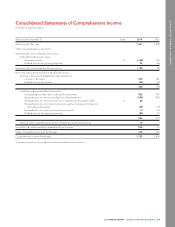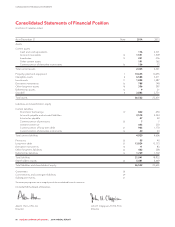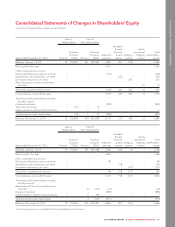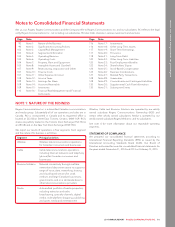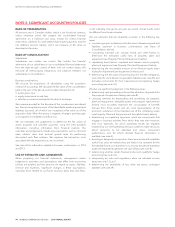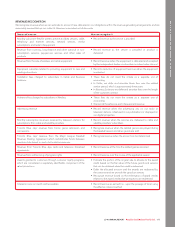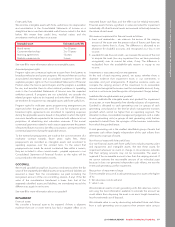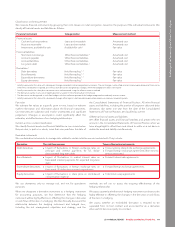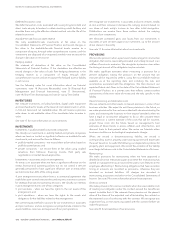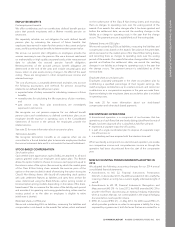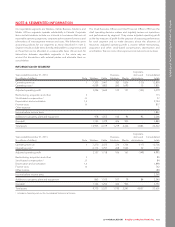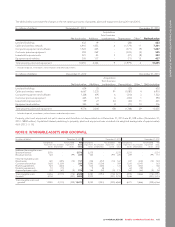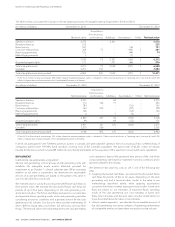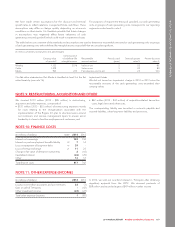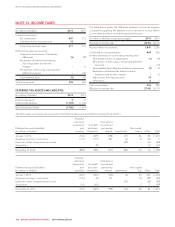Rogers 2014 Annual Report Download - page 102
Download and view the complete annual report
Please find page 102 of the 2014 Rogers annual report below. You can navigate through the pages in the report by either clicking on the pages listed below, or by using the keyword search tool below to find specific information within the annual report.NOTES TO CONSOLIDATED FINANCIAL STATEMENTS
pre-tax rate that reflects current market assessments of the time value
of money and the risks specific to the asset. Estimated cash flows are
based on management’s assumptions and are supported by external
information.
The above concepts used to determine the recoverable amount
require significant estimates, such as:
• future cash flows;
• terminal growth rate; and
• discount rates applied.
If our estimate of the asset’s or cash generating unit’s recoverable
amount is less than its carrying amount, we reduce its carrying amount
to the recoverable amount and recognize the loss in net income
immediately.
We reverse a previously recorded impairment loss if our estimate of a
previously impaired asset’s or cash generating unit’s recoverable
amount has increased such that the impairment recorded in a previous
year has reversed. The reversal is recognized by increasing the asset’s
or cash generating unit’s carrying amount to our new estimate of its
recoverable amount. The new carrying amount cannot be higher than
the carrying amount we would have recorded if we had not recognized
an impairment loss in previous years. We do not reverse impairment
losses recognized for goodwill.
INCOME TAXES
Income tax expense includes both current and deferred taxes. We use
judgement to interpret tax rules and regulations to calculate the
expense recorded each period. We recognizeincometaxexpensein
net income unless it relates to an item recognized directly in equity or
other comprehensive income.
Current tax expense is tax we expect to pay or receive based on our
taxable income or loss during the year. We calculate the current tax
expense using tax rates enacted or substantively enacted as at the
reporting date, and including any adjustment to taxes payable or
receivable related to previous years.
Deferred tax assets and liabilities arise from temporary differences
between the carrying amounts of the assets and liabilities we record in
our Consolidated Statements of Financial Position and their respective
tax bases. We calculate deferred tax assets and liabilities using enacted
or substantively enacted tax rates that will apply in the years the
temporary differences are expected to reverse.
Deferred tax assets and liabilities are offset if there is a legally
enforceable right to offset current tax liabilities and assets and they
relate to income taxes levied by the same authority on:
• the same taxable entity; or
• different taxable entities where these entities intend to settle current
tax liabilities and assets on a net basis or the tax assets and liabilities
will be realized and settled simultaneously.
We recognize a deferred tax asset for unused losses, tax credits and
deductible temporary differences to the extent that it is probable that
future taxable income will be available to use the asset. We use
judgement to evaluate whether we can recover a deferred tax asset
based on our assessment of existing tax laws, estimates of future
profitability and tax planning strategies.
We rely on estimates and assumptions when determining the amount
of current and deferred tax, and take into account the impact of
uncertain tax positions and whether additional taxes and interest may
be due. If new information becomes available and changes our
judgement on the adequacy of existing tax liabilities, these changes
would affect the income tax expense in the period that we make this
determination.
See note 12 for more information about our income taxes.
EARNINGS PER SHARE
We calculate basic earnings per share by dividing the net income or
loss attributable to our Class A and B shareholders by the weighted
average number of Class A and B shares outstanding during the year.
We calculate diluted earnings per share by adjusting the net income or
loss attributable to Class A and B shareholders and the weighted
average number of Class A and B shares outstanding for the effect of
all dilutive potential common shares. We use the treasury stock
method for calculating diluted earnings per share, which considers the
impact of employee stock options and other potentially dilutive
instruments.
See note 13 for our calculations of basic and diluted earnings per
share.
FOREIGN CURRENCY TRANSLATION
We translate amounts denominated in foreign currencies into
Canadian dollars as follows:
• monetary assets and monetary liabilities – at the exchange rate in
effect as at the date of the Consolidated Statements of Financial
Position
• non-monetary assets, non-monetary liabilities and related
depreciation and amortization expenses – at the historical exchange
rates
• revenue and expenses other than depreciation and amortization – at
the average rate for the month in which the transaction was
recorded.
FINANCIAL INSTRUMENTS
Recognition
We initially recognize cash and cash equivalents, accounts receivable,
debt securities and accounts payable and accrued liabilities on the
date they originate. All other financial assets and financial liabilities are
initially recognized on the trade date when we become a party to the
contractual provision of the instrument.
98 ROGERS COMMUNICATIONS INC. 2014 ANNUAL REPORT



